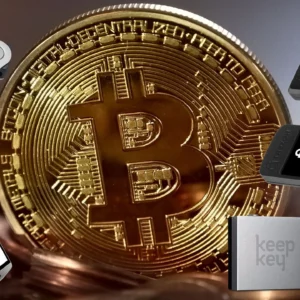Cold Wallets have become the gold standard for long-term Bitcoin storage, combining air-gapped security with user control. As the crypto space matures, 2025 brings new entrants and refinements to established devices. Whether you’re a hodler safeguarding years’ worth of gains or a newcomer seeking peace of mind, this guide walks you through the best cold wallets for storing Bitcoin safely in 2025, comparing features, prices, and security trade-offs so you can make an informed choice.
Why Choose a Cold Wallet for Bitcoin Storage?
Cold wallets (also known as hardware wallets) store your private keys offline, drastically reducing exposure to online attacks. Unlike hot wallets—mobile or desktop apps constantly connected to the internet—cold storage is immune to phishing, malware and exchange hacks. In fact, experts agree that for holding significant amounts of Bitcoin, cold storage remains indispensable:
- Air-gapped Security: Devices like the Coldcard Mk4 operate completely offline from seed generation to transaction signing, thwarting remote exploits (Coin Bureau).
- Physical Possession: You retain sole custody—unlike exchanges or custodial services—so you’re not at risk of platform failures or regulatory seizures.
- Compatibility & Ecosystem: Modern cold wallets integrate with mobile and desktop wallets (e.g. Ledger Live, Trezor Suite), making on-chain management smoother without sacrificing security (Ledger).
Key Criteria for Selecting the Best Cold Wallets
When evaluating cold wallets in 2025, consider:
- Supported Coins & Standards
- Bitcoin-only vs multi-currency (e.g., Ethereum, altcoins)
- Compatibility with BIP-39/BIP-44/BIP-84 standards
- Security Architecture
- Secure Element vs open-source microcontroller
- Air-gapped (no USB/Bluetooth) vs Bluetooth-enabled
- User Experience
- Display type (monochrome, color touchscreen)
- Backup & recovery (seed phrases, Shamir Backup, multisig)
- Form Factor & Durability
- Size, battery life, ruggedness
- Materials (metal plates, tamper-evident packaging)
- Price & Value
- Entry-level vs premium device
- Warranty & customer support
- Open Source vs Closed Source
- Community-audited firmware vs proprietary code
- Transparency can enhance trust, but may trade off industrial-grade secure elements
Top Cold Wallets Compared in 2025
Below is a snapshot of the leading hardware wallets available this year, highlighting their standout attributes:
| Wallet Model | Best For | Security | Connectivity | Display | Price (USD) | Open Source |
|---|---|---|---|---|---|---|
| Ledger Nano X | Beginners | Secure Element (CC EAL5+) | Bluetooth, USB-C | Mono OLED | $149 | No (partial) |
| Trezor Model T | Advanced Users | Open-source MCU | USB-C | Color Touchscreen | $169 | Yes |
| Coldcard Mk4 | Bitcoin Purists | Air-gapped, open-source | MicroSD only | Mono OLED | $157.94 | Yes |
| NGRAVE Zero | Premium Security & Recovery | Fully Air-gapped, NVRAM | QR-code (camera) | Mono LCD | $398 | Yes |
| Cypherock X1 | Multisig Setups | Multisig, secure element | Bluetooth, USB-C | Mono OLED | $199 | Partial |
| Block Bitkey | Fingerprint-based Access | Quartz encapsulated, fingerprint | NFC | No display | $350* | No |
*Price for Block Bitkey is estimated based on recent announcements (Time).
In-Depth Reviews of the Best Cold Wallets
Ledger Nano X
Best For: Beginners and mobile-first users
Security:
- Uses a CC EAL5+ certified secure element for key storage.
- Firmware is signed by Ledger but not fully open source, prompting debates in the community (99Bitcoins).
Connectivity & UX:
- Bluetooth + USB-C enables seamless mobile integration via the Ledger Live app for iOS and Android (Ledger).
- Monochrome OLED display and two-button interface: simple but occasionally cumbersome for long addresses.
Features & Backup:
- Supports thousands of cryptocurrencies beyond Bitcoin.
- Standard 24-word BIP-39 seed; can integrate with external seed tools.
Price: $149
Pros:
- Excellent ecosystem & widespread adoption
- Wireless convenience for on-the-go management
Cons: - Closed-source secure element
- Potential Bluetooth attack surface (mitigated by pairing codes)
Trezor Model T
Best For: Users valuing open-source transparency and advanced features
Security:
- Runs on an open-source ARM Cortex-M4 MCU, fully audited by the community (Hardware-Wallets.NET).
- Lacks secure element, but mitigates risk through transparent code.
Connectivity & UX:
- USB-C only.
- Large color touchscreen simplifies PIN entry and passphrase protection, reducing phishing risks.
Features & Backup:
- Supports over 1,000 coins and tokens.
- Offers Shamir Backup (SLIP-0039) for splitting seed into multiple shares.
Price: $169 (often discounted to $159) (BitDegree)
Pros:
- Fully open-source firmware
- Intuitive touchscreen
- Advanced recovery options (Shamir Backup)
Cons: - No Bluetooth (desktop-only for signing)
- Slightly bulkier and pricier than entry-level wallets
Coldcard Mk4
Best For: Bitcoin purists and maximum security seekers
Security:
- Entirely air-gapped: no direct USB or wireless connectivity (Coin Bureau).
- Stores keys in a secure element; firmware open source and verifiable.
Connectivity & UX:
- Transactions imported/exported via MicroSD card—eliminates malware risk.
- Monochrome OLED and numeric keypad for PIN entry; steeper learning curve.
Features & Backup:
- Supports BIP-174 PSBT workflows for multisig setups.
- Plausible deniability via duress PINs.
Price: $157.94 (CoinLedger)
Pros:
- Unmatched air-gapped security
- Bitcoin-only focus reduces attack surface
Cons: - Not beginner-friendly
- No support for altcoins
NGRAVE Zero
Best For: Users demanding end-to-end air-gapped security and advanced recovery
Security:
- Uses non-volatile RAM (NVRAM) to prevent cold boot attacks.
- Entirely air-gapped, QR-code communication (camera on host device) (CoinLedger).
Connectivity & UX:
- QR-based signing avoids USB/Bluetooth.
- Monochrome e-ink display; proprietary interface may feel clunky.
Features & Backup:
- “Shields” for social recovery and custom backup schemes.
- Rugged metal housing; water and dust resistant.
Price: $398
Pros:
- Premium build & features
- Strong focus on recovery and backup flexibility
Cons: - High price
- Proprietary software stack
Cypherock X1
Best For: Multisig aficionados and bespoke security setups
Security:
- Secure element + multisig support across three devices for safe key splits.
- Firmware partly open source; community audits ongoing.
Connectivity & UX:
- Bluetooth + USB-C connectivity.
- Mono-OLED with two-button nav—adequate but not as slick as touchscreens.
Features & Backup:
- On-device pairing via QR codes.
- Integration with multiple blockchain ecosystems.
Price: $199 (CoinLedger)
Pros:
- Built-in multisig workflows
- Cross-platform support
Cons: - Setup complexity for novices
- Partial open source
Block Bitkey
Best For: Fingerprint-based quick access & mainstream self-custody
Security:
- Quartz-encased device with built-in fingerprint sensor—unlock via biometric tap (Time).
- Relies on “trusted contacts” for social recovery, a novel approach but with social engineering risks.
Connectivity & UX:
- NFC-based communication; no display.
- Extremely streamlined “tap to unlock” UX.
Features & Backup:
- Fingerprint + phone pairing.
- Preassigned contacts can restore access if both phone and device are lost.
Price: Estimated $350
Pros:
- Extremely user-friendly
- Biometric convenience
Cons: - Proprietary and closed source
- Recovery relies on third parties
Implications & Insights: The 2025 Cold Wallet Landscape
- Bluetooth vs Air-gapped Trade-offs
- Wireless devices (Ledger, Cypherock) offer convenience at marginally higher attack surface, whereas air-gapped models (Coldcard, NGRAVE) maximize security at the cost of UX friction.
- Open Source Momentum
- Trezor and Coldcard’s open-source approach fosters community trust, while closed-source elements in Ledger and Block products continue to draw scrutiny.
- Premium Features & Recovery
- High-end models (NGRAVE Zero) now prioritize advanced backup schemes (Shamir backup, social recovery), reflecting user demand for robust long-term custody solutions.
- Emerging Biometric & Social Models
- Innovations like Block Bitkey show that self-custody can embrace mainstream UX paradigms—fingerprint unlocking and trusted contacts—though they introduce new threat vectors.
- Multisig & Institutional Use
- Devices supporting native multisig workflows (Cypherock X1, Coldcard) point to growing institutional and shared-custody use cases as Bitcoin adoption matures.
Best Cold Wallets for Bitcoin: Which One Is Right for You?
- If you’re new to crypto:
- Ledger Nano X offers a gentle learning curve, extensive coin support, and mobile integration at an accessible price.
- If you value transparency:
- Trezor Model T’s open-source firmware and intuitive touchscreen strike a balance between security and UX.
- If you’re a Bitcoin purist:
- Coldcard Mk4 delivers uncompromising air-gapped security with community-audited code.
- If you need premium backup options:
- NGRAVE Zero excels with custom backup shields and NVRAM cold-boot protection.
- If multisig is your priority:
- Cypherock X1 simplifies multisig setups across devices with secure element protection.
- If mainstream ease matters most:
- Block Bitkey’s biometric unlock and trusted contacts make self-custody approachable—at a trade-off in open-source assurance.
Conclusion
In 2025, storing Bitcoin safely remains a blend of security, convenience, and personal risk tolerance. Whether you prioritize the iron-clad defenses of air-gapped wallets or the smooth experience of Bluetooth-enabled devices, there’s an option tailored to your needs. By weighing supported assets, security architecture, user experience, and budget, you can confidently select one of the best cold wallets for storing Bitcoin safely in 2025—and sleep soundly knowing you control your keys, and thus, your fate.
Ready to secure your Bitcoin? Explore the devices that fit your strategy, back up your seed properly, and remember: no one can steal what they can’t access.







This Post Has 2 Comments